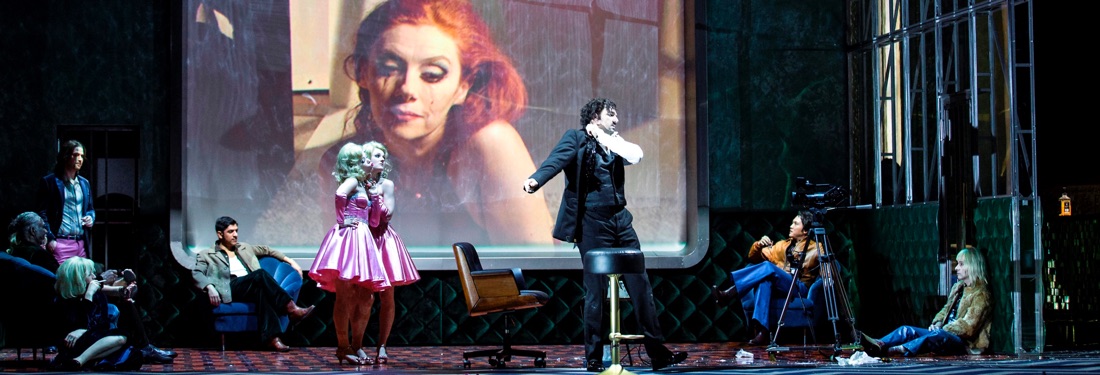

Music Director James Conlon took his place at the podium and proceeded to set the LA Opera Orchestra on fire with a reading of Bellini’s Sinfonia powerful in volume and passionate of purpose with brilliant string articulation and horns that were spot on from the onset. Then the curtain rose on the courtyard of a commune in Santa Fe where the residents share a little herb garden (I know). My tiny rush of disappointment was quickly extinguished when Morris Robinson strode on stage as Oroveso accompanied by the men of the chorus. He then blew a hole clean through his opening aria.
I won’t lie, it did take Mr. Robinson a few moments to “find the pocket,” four or five lines of accompanied recitative. But from then on, and for the rest of the evening, he poured forth the kind of legato-heavy, sepulchral sound that you generally get to hear in this role only on studio recordings.
Russell Thomas as Pollione took the stage next and even in the recitative you could tell this is an important voice. The tone was burnished but with real squillo ring on top and excellent breath control He’s also not afraid to sing mezza voce, quivering with delicious ardor in the romantic passages. His tread was cautious in the opening aria but which tenor’s is not? Once past that initial hurdle it was full out bull canto ‘till the finale.

Scale work was scruplous and, although no one would mistake Ms. Meade for a native Italian, her diction was clear and correct. The ovation in the theatre was thunderous. She attempted only only one verse of “Ah bello a me ritorna,” but I forgive her. There is an enormous difference between someone who can manage the role of Norma and someone who was born to sing it. Ms. Meade most assuredly falls into the later category and it will be a pleasure to hear her continuing artistic growth in the part.
Then Jamie Barton as Adalgisa strode into the sacra selva and I was racking my brain to to recall the last time I wanted to use the word “glowing” to describe a voice. Perhaps she isn’t entirely comfortable with the very highest notes of this role but on that point she’s also in good company. She does make a strong case for a mezzo Adalgisa especially beside a voice as bright as Ms. Meade’s.

I’m familiar with the work of the director Anne Bogart, because SITI Company, which she helped found, has staged some of the greek tragedies at the Getty Villa here and she’s directed. I’ve enjoyed both her takes on The Persians by Aeschylus and a stunning production of The Trojan Women adapted from Euripides. Although she’s adept at bringing modern life to a classical format it becomes a whole other set of challenges when you have people singing introspective music about their emotions.
She did a creditable job in trying to fill some of Bellini’s endless preludes and postludes with action and adding some dramatic momentum. She even gave the singers an excuse to linger on the stage so they could enjoy some well-deserved applause. “Mira, o Norma’ developed into a group hug with the kids (which worked) and they returned, very potently, for the finale ultimo. Robinson’s reactions here were especially compelling.

Maestro Conlon’s gifts as an accompanist were absolute here; you would have never known that this was his first Norma. The work of the chorus, which can quickly dwindle to tedium in bel canto for the audience, was especially alert and dynamically varied. Even the offstage banda was handled well and excellent coordination with the pit. As to the edition we did have a few cuts including a section of Norma’s interrogation of Pollione, removing the bulk of his florid singing. We did get quite a few extra measures of orchestral music in the finale which I’d heard before only on the live EMI recording with Riccardo Muti.
Two performances remain and I have only this to say: “Ite sul colle, O Druidi!”
Photos: Ken Howard
Reach your audience through parterre box!
parterre box, “the most essential blog in opera” (New York Times), is now booking display and sponsored content advertising for the 2023-2024 season. Join Carnegie Hall, Lincoln Center, Warner Classics and many others in reaching your target audience through parterre box.
parterre box, “the most essential blog in opera” (New York Times), is now booking display and sponsored content advertising for the 2023-2024 season. Join Carnegie Hall, Lincoln Center, Warner Classics and many others in reaching your target audience through parterre box.
Latest on Parterre
Merry Widow | Finger Lakes, NY | July 25-28
Geneva Light Opera’s production of Lehar’s The Merry Widow will feature prize-winning baritone Bryan Murray and soprano Alexis Olinyk in the superb acoustics of in the landmark Smith Opera House in Geneva, New York on July 25, 27, and 28. A small city on the north end of the largest of NY’s Finger Lakes, Geneva…
Geneva Light Opera’s production of Lehar’s The Merry Widow will feature prize-winning baritone Bryan Murray and soprano Alexis Olinyk in the superb acoustics of in the landmark Smith Opera House in Geneva, New York on July 25, 27, and 28. A small city on the north end of the largest of NY’s Finger Lakes, Geneva…
parterre in your box?
Get our free weekly newsletter delivered to your email.

























Comments